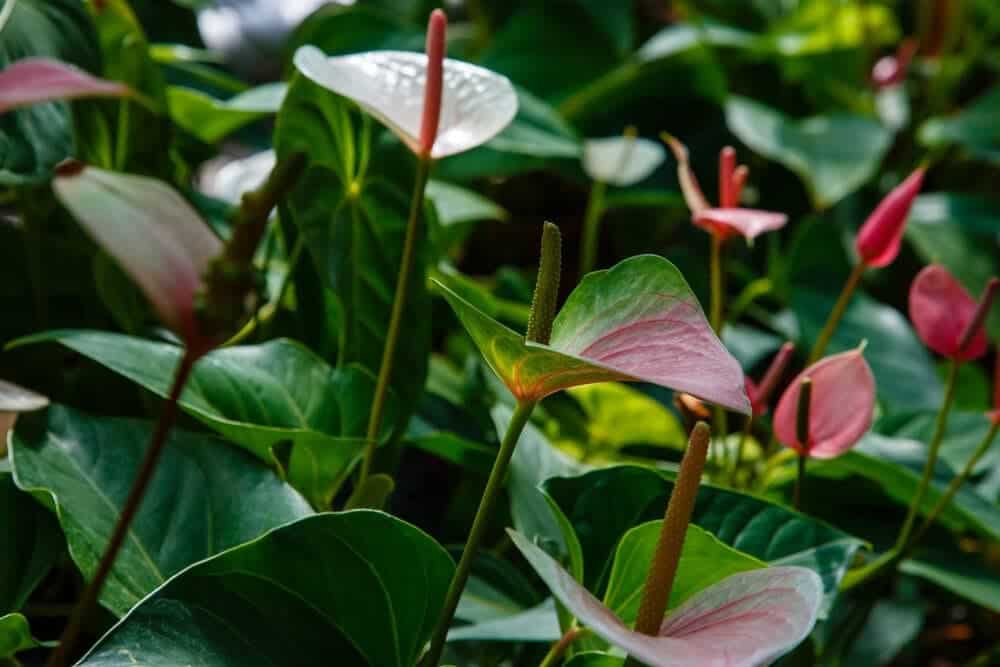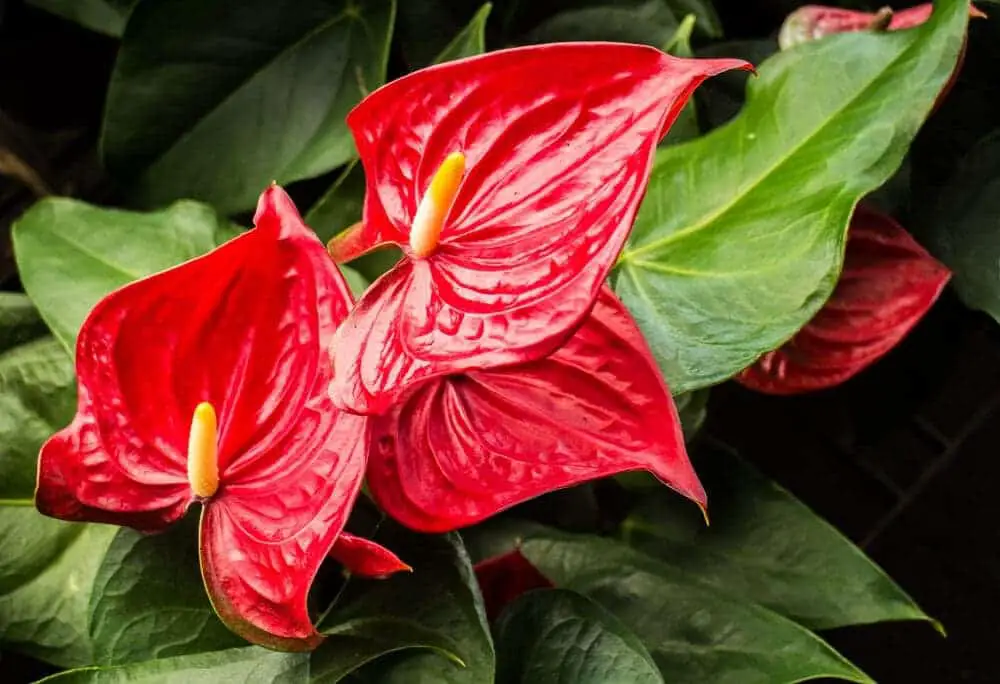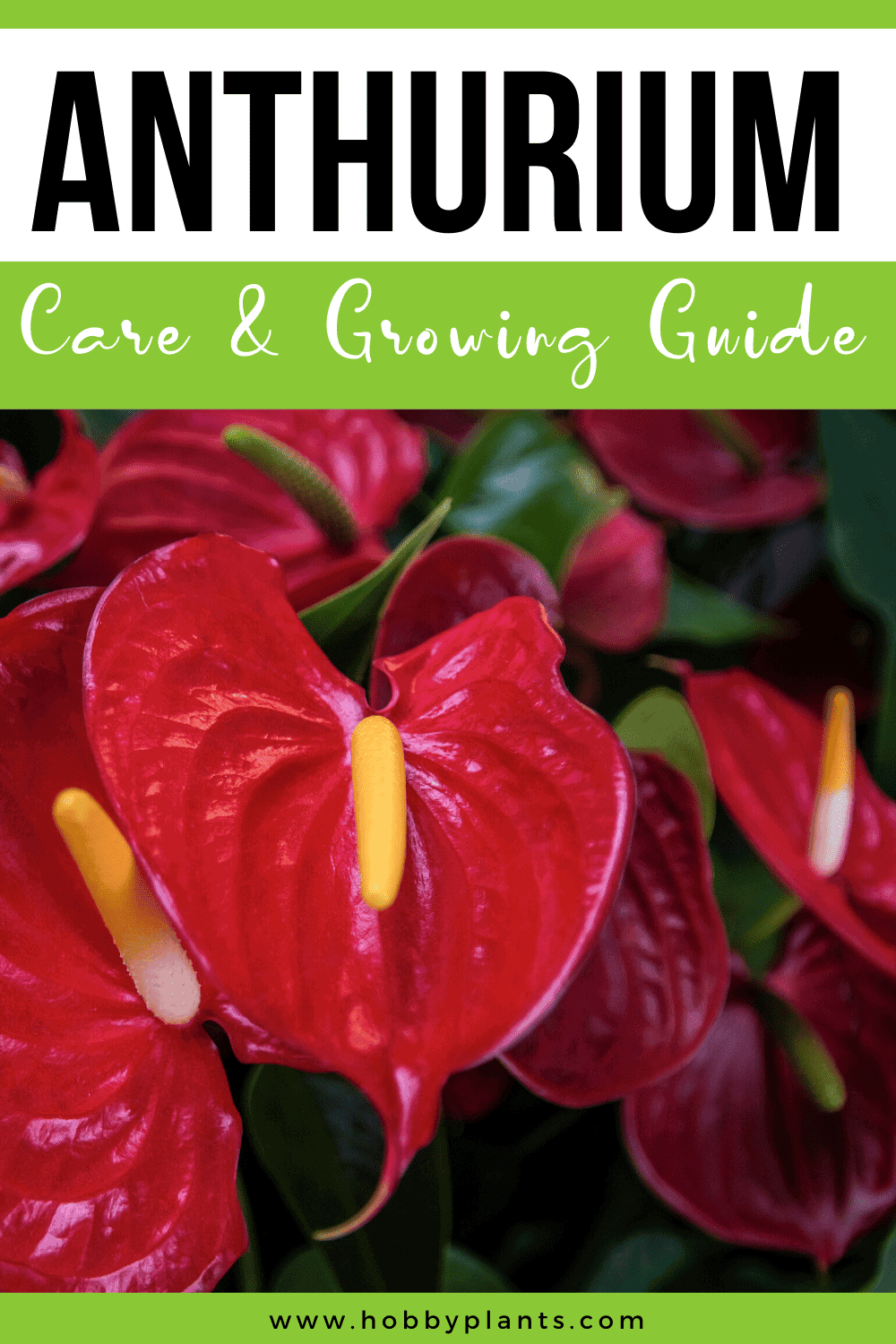The Anthurium is native to tropical America and in a genus of more than 800 species found in the New World tropics like Mexico and northern Argentina.
They are grown for their ornamental leaves and colored flower spathes. It makes a beautiful landscape plant for your garden but can also be a houseplant. They are easy to care for as long as you provide a few important elements.
Anthurium Care & Growing Guide
1. Light Requirement
Although the Anthurium can tolerate all levels of indirect light, the ones that only have low light will grow slower and have fewer flowers. They cannot have direct light at this will burn their leaves. The ideal light is indirect, bright light, but never direct sunlight.
2. Water
The Anthurium plant needs to be watered regularly but you want to make sure that you do not overwater it. You should only water the plant when the soil is dry to touch. If it gets too dry in a planter, the growth will slow down and it will be hard to re-wet the root ball. To rehydrate a too dry root ball, soak the planter the Anthurium is in for an hour in water.
Immediately after you plant them, you will need to water them. You will only need to fertilize the Anthurium once every three to four months with one-quarter strength fertilizer. If you want better flowers, use a fertilizer that has a higher phosphorus number.
3. Climate
USDA Hardiness Zone 10 or high
4. Soil
The soil for the Anthurium plant needs to be free draining but still has the ability to hold some water. When growing it as a houseplant, you should use a mixture of half perlite or orchid soil and half potting soil. They grow well in soil ranging from sandy loam to heavy clay, as long it can drain.
5. Temperature
They do best in temperatures that mimic where they come from, which is the South American rainforests. The idea temperatures would be between 70 and 90 degrees Fahrenheit with humidity between 80 and 100 degrees Fahrenheit.

6. Repotting
You will only need to repot your Anthurium about once a year or when they outgrowth the pot they are in. When you repot your plant, you should do it in the spring. Repot it in a pot with a 20% bigger diameter than the previous pot. When repotting, mix into the soil some Anthurium feed so it will have some in reserve for growing.
7. Speed of Growth
They are considered moderate growers but if the conditions are right, they can grow faster. Their rate of growth will slow down with low light.
8. Height and Spread
The stems of the Anthurium can grow to a height of 15-20 inches, but it depends on the size of the spathe, which is the flower. The leaves are large, simple, colored on the long stems, or stalks. After planting Anthurium, you should stake them for support.
9. Flowers
The flowers of the Anthurium will last about six weeks. They are heart-shaped and red in color. The flower is actually a waxy, modified leaf that flares out from the base of a fleshy spike. They can also come in other shades of red besides a bright red.
10. Trimming
These plants do not require trimming but you will need to remove any unsightly or dead foliage along with brown or faded flowers.

Is Anthurium Poisonous?
Every part of the Anthurium is poison if ingested for humans and animals. If ingested, it could cause mild stomach disorders. The sap from the plant can also cause skin irritations.
Can Anthurium grow in Water?
No, they must be grown in soil.
How to get Anthurium to Flower?
In order to get them to flower, they must have the right conditions, such as the right light, soil, and humidity. In the winter months, there will be fewer flowers. When the Anthurium stops producing flowers you can change where you have the plant to give it more light. In the spring, do not feed your plant for six weeks, even as long as two months and a little less water. This gives the chance for the plant to rest or hibernate.
As the days get sunnier and warmer you can start the feeding process again and give it more water. This will help to ensure that the plant is going to quickly produce more flowers. Before it flowers, you will see a new leaf.
Also read: Yucca Elephantipes Care & Growing Guide
Common Plant Diseases
Anthurium is prone to a variety of diseases, including:
- Root rot—this comes from overwatering and can kill the roots so watch how much you water your plant.
- Brown leaves or leaf tips—too much or too little water. Feel the soil. If the soil is too dry it needs water, but if it is too wet, wait a week before you water it again.
- Yellowish leaves—this can mean that it is getting too much sunlight so you need to move your houseplant where it is getting less sunlight.
- Flowers’ staying too green— this means it is not getting enough light for it to bloom so it needs to be moved to get more indirect light.
Keep reading:
Conclusion
- The most common use for this plant is as a blooming tabletop plant but you can get some smaller ones, about a four-inch pot size that you can use in a dish garden.
- They are also commonly known as the Red peace lily or Flamingo Flower
- The Anthurium are popular foliage plants so many are grown for their attractive flowering bracts.
- The Anthurium will need to rest for six weeks at 59 degrees Fahrenheit with little water to allow the plant to regrow in when the weather gets warmer.
- When planting, make sure that you do not plant too deep as this can result in rotting of the roots and stems.
- You will need to mulch the Anthurium occasionally
- Spray it with a light mist of water ever so often so it feels like it is the tropics.

Victoria is the owner and main author of hobby plants. She loves spending her free time in her garden planting and taking care of her plants. Victoria hopes you enjoy the content here!
![Queen Of The Night Flower [Complete Plant Care Guide] Queen Of The Night Flower [Complete Plant Care Guide]](https://www.hobbyplants.com/wp-content/uploads/2022/07/queen-of-the-night-flower-300x158.jpg)
![Mother Of Thousands Plant [Complete Plant Care Guide] Mother Of Thousands Plant [Complete Plant Care Guide]](https://www.hobbyplants.com/wp-content/uploads/2022/07/mother-of-thousands-plant-300x158.jpg)
![How Often Should You Water Pothos? [Complete Care Guide] How Often Should You Water Pothos? [Complete Care Guide]](https://www.hobbyplants.com/wp-content/uploads/2022/07/how-often-to-water-pothos-300x158.jpg)
![Can Snake Plants Live Outside? [COMPLETE CARE GUIDE] Can Snake Plants Live Outside? [COMPLETE CARE GUIDE]](https://www.hobbyplants.com/wp-content/uploads/2022/08/can-snake-plants-live-outside-300x158.jpg)
![Majesty Palm Plant Care: [Complete Beginner's Guide] Majesty Palm Plant Care: [Complete Beginner's Guide]](https://www.hobbyplants.com/wp-content/uploads/2022/08/majesty-palm-care-300x158.jpg)
![Exotic Angel Plant Care: [Complete Beginner's Guide] Exotic Angel Plant Care: [Complete Beginner's Guide]](https://www.hobbyplants.com/wp-content/uploads/2022/08/exotic-angel-plant-care-300x158.jpg)
![Do Coleus Like Sun Or Shade: [Complete Care Guide] Do Coleus Like Sun Or Shade: [Complete Care Guide]](https://www.hobbyplants.com/wp-content/uploads/2022/08/coleus-sun-or-shade-300x158.jpg)
![Snow White Waffle Plant: [Complete Care Guide] Snow White Waffle Plant: [Complete Care Guide]](https://www.hobbyplants.com/wp-content/uploads/2022/08/snow-white-waffle-plant-300x158.jpg)
![Waffle Plant Care: [Complete Beginner's Guide] Waffle Plant Care: [Complete Beginner's Guide]](https://www.hobbyplants.com/wp-content/uploads/2022/08/waffle-plant-300x158.jpg)
![Bird Of Paradise Plant Care: [Complete Beginner's Guide] Bird Of Paradise Plant Care: [Complete Beginner's Guide]](https://www.hobbyplants.com/wp-content/uploads/2022/08/bird-of-paradise-plant-300x158.jpg)
![Purple Passion Plant Care: [Complete Beginner's Guide] Purple Passion Plant Care: [Complete Beginner's Guide]](https://www.hobbyplants.com/wp-content/uploads/2022/08/purple-passion-plant-care-300x158.jpg)
![China Doll Plant Care: [Complete Beginner's Guide] China Doll Plant Care: [Complete Beginner's Guide]](https://www.hobbyplants.com/wp-content/uploads/2022/09/china-doll-plant-care-300x158.jpg)